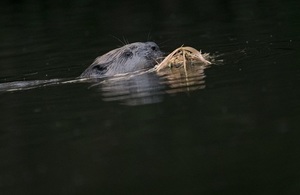A pair of beavers will be heading to a new home in North Essex as part of a pioneering natural flood management scheme for East Anglia.

A pair of beavers will be heading to a new home in North Essex as part of a pioneering natural flood management scheme for East Anglia.
It is hoped the Eurasian Beavers will improve biodiversity and help to reduce local flood risk as part of a new approach to flood prevention at the historic Spains Hall Estate, just upstream of the picturesque village of Finchingfield.
The Environment Agency is working in partnership with Spains Hall Estate, the Essex & Suffolk Rivers Trust, Essex Wildlife Trust and others, with funding from partners including the Anglian Eastern Regional Flood and Coastal Committee (RFCC).
The whole story will be captured in a documentary series, due to be screened next year, overseen by renowned wildlife filmmaker Russell Savory for independent film company Copper Productions. The beavers will have a territory covering 4 hectares, with plenty of trees to get their teeth stuck into and a boundary fence helping to keep them safe. Beavers have not been found in Essex for 400 years since they were hunted to extinction, although they have been reintroduced in small numbers in other parts of the country in recent years.
A second element of the project will involve man-made natural flood management measures being introduced on a separate strand of Finchingfield Brook at Spains Hall Estate. As well as helping to slow the flow after heavy rain, the scheme should also create wetland that will slowly release water in drier periods.
Spains Hall Estate owner Archie Ruggles-Brise said he was excited to welcome the beavers to the estate, home to his family for 250 years.
He said:
We have experienced first-hand the disruption caused by flooding in Finchingfield so we are excited to be able to contribute to this novel approach to reducing flood risk, an undeniable public good.
The added attraction of being able to pit nature against man to see who 'does it better' will be a rare chance to learn and adapt our approach.
We hope the project will also focus a spotlight on our little corner of rural North West Essex, a hidden gem normally only enjoyed by those in the know. We are keen to welcome more people to the area so they can see for themselves what they might be able to do back home.
The Environment Agency's Matt Butcher said it was a "pioneering" project for East Anglia. He said:
Natural Flood Management can be a great way to reduce flood risk for communities where traditional flood defences are not appropriate. Introducing leaky dams along Finchingfield Brook should slow the flow and reduce flood peaks downstream whilst improving habitat in this fantastic landscape.
The beavers bring another exciting dimension, as we can assess how effective they are at creating amazing new wetlands and as flood engineers.
Essex County Councillor and RFCC member Simon Walsh said:
Natural Flood Management provides many opportunities to explore innovative solutions for local flood risk concerns. Working with nature, we can often achieve successful outcomes to better protect people and property from flooding, whilst at the same time improving the environment for wildlife.
Beavers are renowned for felling trees and building dams and to use them for natural flood management is really exiting, as not only are more properties protected from flood risk, but animals once lost to the British countryside are being re-introduced in lowland Britain.
Darren Tansley, river catchment co-ordinator for Essex Wildlife Trust, said:
Working with Government, other conservationists and a forward thinking landowner to reduce flood risk in Finchingfield is an ideal opportunity for Essex Wildlife Trust. But the partners that eclipse us all are surely the beavers; natural engineers of our freshwater environment that we hope will trigger an explosion of biodiversity in their wake.
Essex & Suffolk Rivers Trust chairman Andrew Davies said:
This project brings river improvement through Natural Flood Management, betters the river environment for many other species and by raising the profile of beavers, educates us all. It achieves many of our objectives as a Rivers Trust. It is a very exciting project for us to be involved with.
Notes
Hunted to extinction
The Eurasian Beaver is a large semi-aquatic native mammal that was once widespread throughout Britain. They were hunted to extinction by the beginning of the 16th Century for their meat, fur and scent glands. The species was reintroduced into parts of Scotland since 2001 and earlier this year a pair were released into the Forest of Dean in Gloucestershire, an event attended by Environment Secretary Michael Gove through a partnership with the Forestry Commission and Natural England.
Keystone species
Beavers are a 'keystone species' - playing an important role in wetland ecology by creating ecosystems that provide habitats for many other plant, insect and mammal species. Few other animals, aside from humans, have the ability to so drastically modify and shape their surrounding environment.
For this reason beavers are often referred to as "ecosystem engineers". Beavers are well known for their ability to fell trees to dam shallow watercourses and create pools to make them feel safe.
The associated wetlands, interconnecting beaver canals, coppiced woodland, glades and deadwood provides rich and diverse habitat for an abundance of wildlife including plants, insects, amphibians, reptiles, birds and mammals.
For more details visit the project web page www.spainshallestate.co.uk/nfm_beavers






